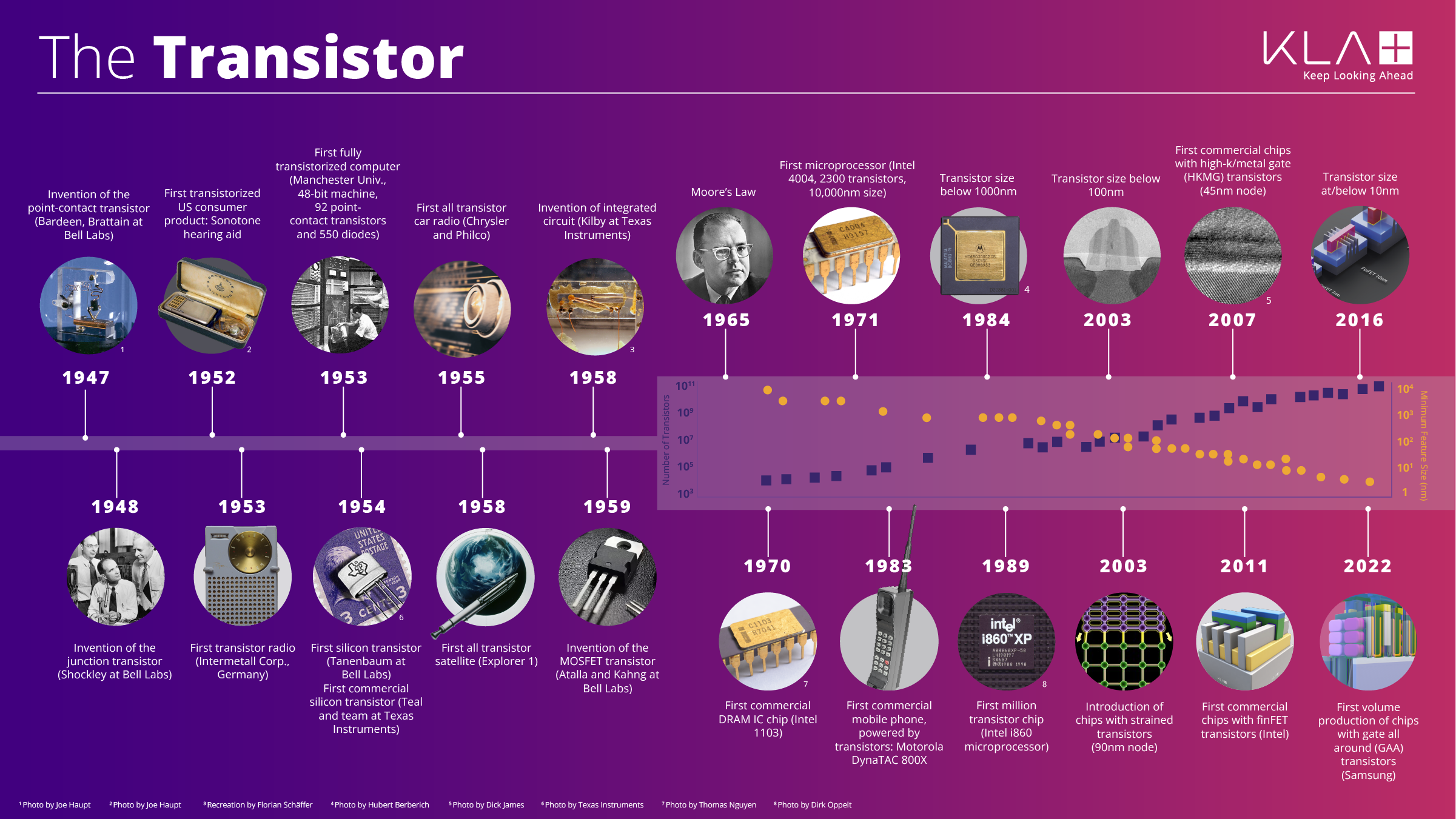Semiconductors chips – the heart of our modern electronic devices – are built atop a technology first introduced 75 years ago today: the transistor.
In concert with our peers throughout the technology industry – including IEEE and the Electron Devices Society – KLA celebrates the innovation of John Bardeen and Walter Brattain whose lab demonstration of a point-contact transistor on Dec. 16, 1947, changed the course of modern electronics. The transistor, later refined and cultivated by William Shockley at Bell Labs, was considerably more reliable and efficient than the legacy vacuum tubes commonly used at the time in TVs, radios, telephone networks and early computers.
Crucially, these early transistors were 1/50th the size of vacuum tubes.

Click here to View a PDF version
Prior to the transistor’s invention, racks and in some cases rooms full of hardware components were required to power thermionic tube-based communication and computing devices. The advent of the tiny, solid state transistor meant that these devices could eventually be shrunk to the pocket-sized and smaller form factors we currently enjoy. The semiconductor chips housed in today’s lightweight and portable electronic devices can contain transistors numbering into the billions.
Functionally, the transistor is designed for two uses. A transistor can regulate and amplify the flow of an electrical signal leveraging the property of gain to achieve higher output power. Or it can function as a switch, turning current on or off within a circuit (another feature later embraced by Bell Labs after years of reliance on human switchboard operators to establish telephone connections).
Today, the MOSFET (metal–oxide–semiconductor field-effect transistor) is the most widely utilized type of transistor. To provide a sense of the scale and pervasiveness of transistor technology today – and its impact on society, from global connectivity to commerce to space travel – it’s estimated that MOSFETs are the most numerously produced artificial objects ever in recorded human history, with more than 13 sextillion manufactured as of 2018.
The innovation underpinning the humble transistor would set the stage for decades of major leaps forward in transistor technology. As transistors moved from being standalone parts to being integrated on chips, they traveled the path outlined by Moore’s Law, which in the 1975 revision, projected that the number of transistors in an integrated circuit would double every two years. In the early 1970s, chips had a few thousand transistors compared to today’s advanced chips that can have 100 billion to several trillion transistors. During this time the minimum feature size of the transistor on a chip decreased from 10,000 nm to <10nm.
In addition to shrinking in size, transistor process technology evolved with the introduction of both strained transistors and high-k metal gate transistors in the 2000s. And over the last decade, chip manufacturers have evolved the transistor architecture from planar to three-dimensional structures, with finFET transistors widely used in today’s advanced chips and next-generation gate all around (GAA) transistor structures in development.
As transistors have diminished in size and grown in architectural complexity, chip manufacturing processes have also evolved. Production of today’s chips involves hundreds of process steps – lithography, etch, deposition, implant, cleans, polishing, etc. – to create nanoscale structures, often at atomic scale precision. These steps form the billions of transistors and supporting circuitry that comprise a chip, for the hundreds of chips that comprise a wafer, for the tens of thousands of wafers that are produced by one chip manufacturing fab every month, resulting in more than 1 trillion chips that are produced globally every year.
KLA has served a critical role in helping to advance transistor technology. We collaborate closely with chip manufacturers, producing process control solutions that help them understand and solve complex integration challenges when developing next-generation transistor architectures. Our products also serve a key role in volume manufacturing of chips – monitoring the production line for excursions and finding the defects and subtle anomalies that can affect transistor and overall chip functionality and performance.
“The ability to manufacture impossibly complex IC structures at massive commercial scale and speed has been integral to the transistor’s 75-year success story. The innovation demonstrated by Bardeen and Brattain on this day 75 years ago, and the thousands of discoveries and innovations made by semiconductor engineers and scientists in the years that followed, affected the sweep of history, with profound implications for society’s progress. The transistor is behind the electronics and technologies that make the world more accessible, helping us to better understand and connect with one another. KLA is humbled to play a role in enabling this revolution and we remain committed to supporting the R&D that will help advance transistor technology for decades to come.”
Ben Tsai, chief technology officer, KLA
The evolution of the transistor over the last 75 years has helped make electronic devices to become more compact, power efficient and versatile. Billions of transistors are driving the chips in our phones, tablets, cars, computers, smart devices, home automation, satellites and Mars rovers. On this 75th anniversary of the first working transistor, we celebrate the tiny technology that powers our world!
Follow Us